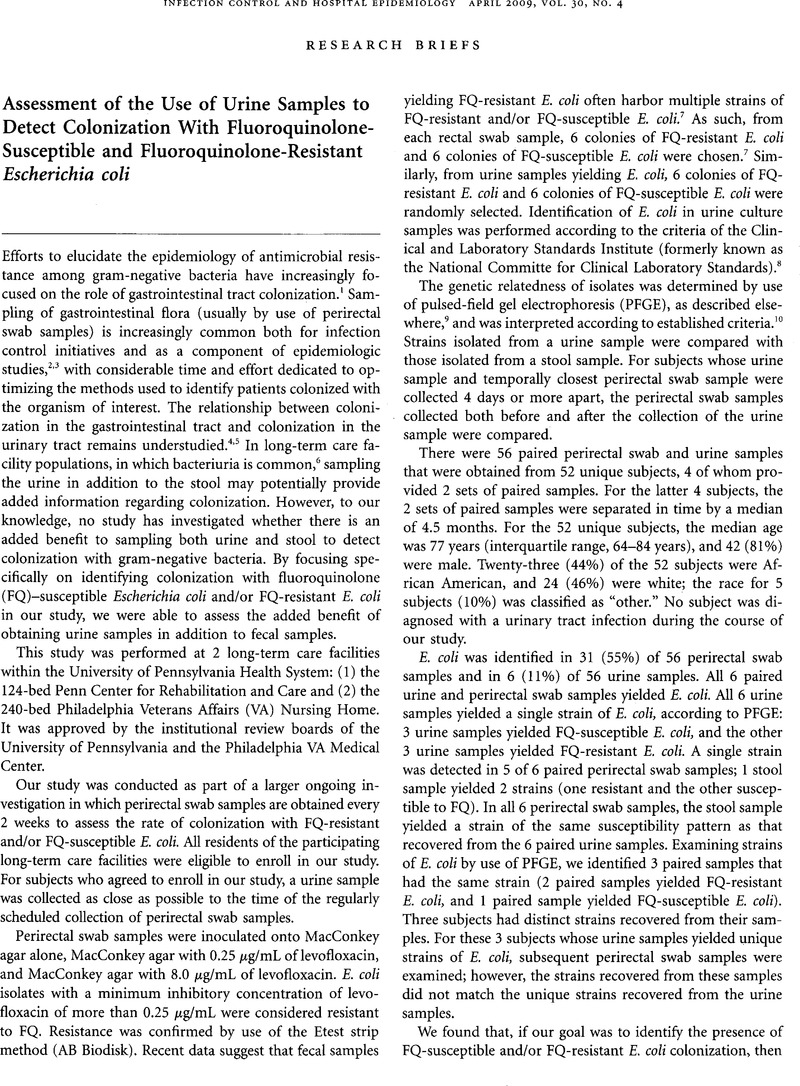No CrossRef data available.
Article contents
Assessment of the Use of Urine Samples to Detect Colonization With Fluoroquinolone-Susceptible and Fluoroquinolone-Resistant Escherichia coli
Published online by Cambridge University Press: 02 January 2015
Abstract
An abstract is not available for this content so a preview has been provided. Please use the Get access link above for information on how to access this content.

- Type
- Research Briefs
- Information
- Copyright
- Copyright © The Society for Healthcare Epidemiology of America 2009
References
1.Donskey, CJ. The role of the intestinal tract as a reservoir and source for transmission of nosocomial pathogens. Clin Infect Dis 2004;39:219–226.Google Scholar
2.Lautenbach, E, Harris, AD, Perencevich, EN, Nachamkin, I, Tolomeo, P, Metlay, JP. Test characteristics of perirectal and rectal swab compared to stool sample for detection of fluoroquinolone-resistant Escherichia coli in the gastrointestinal tract. Antimicrob Agents Chemother 2005;49:798–800.Google Scholar
3.Carratala, J, Fernandez-Sevilla, A, Tubau, F, Dominguez, MA, Gudiol, F. Emergence of fluoroquinolone-resistant Escherichia coli in fecal flora of cancer patients receiving norfloxacin prophylaxis. Antimicrob Agents Chemother 1996;40:503–505.Google Scholar
4.Arbeit, RD, Arthur, M, Dunn, R, Kim, C, Selander, RK, Goldstein, R. Resolution of recent evolutionary divergence among Escherichia coli from related lineages: the application of pulsed field electrophoresis to molecular epidemiology. J Infect Dis 1990;161:230–235.Google Scholar
5.Brumfitt, W. Progress in understanding urinary infections. J Antimicrob Chemother 1991;27:9–22.Google Scholar
6.Nicolle, LE. Urinary tract infection in long-term-care facility residents. Clin Infect Dis 2000;31:757–761.Google Scholar
7.Maslow, JN, Lee, B, Lautenbach, E. Fluoroquinolone-resistant Escherichia coli carriage in long-term care facility. Emerg Infect Dis 2005;11:889–894.Google Scholar
8.National Committee for Clinical Laboratory Standards (NCCLS). Performance standards for antimicrobial susceptibility testing. NCCLS approved standard. Wayne, PA: NCCLS, 2001:M100-S11.Google Scholar
9.Maslow, JN, Mulligan, ME, Arbeit, RD. Molecular epidemiology: application of contemporary techniques to the typing of microorganisms. Clin Infect Dis 1993;17:153–162.Google Scholar
10.Tenover, FC, Arbeit, RD, Goering, RV, et al.Interpreting chromosomal DNA restriction patterns produced by pulsed-field gel electrophoresis: criteria for bacterial strain typing. J Clin Microbiol 1995;33:2233–2239.Google Scholar


